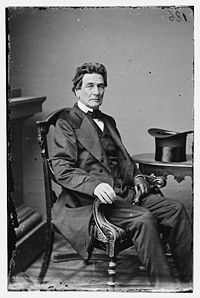Andre B. Roman
This article needs additional citations for verification. (August 2016) |
Andre B. Roman | |
|---|---|
Edward D. White | |
| In office February 4, 1839 – January 30, 1843 | |
| Preceded by | Edward D. White |
| Succeeded by | Alexandre Mouton |
| Personal details | |
| Born | March 5, 1795 near Opelousas, Louisiana |
| Died | January 26, 1866 (aged 70) New Orleans, Louisiana |
| Political party | Whig National Republican |
| Spouse | Aimée Françoise Parent |
André Bienvenue Roman (March 5, 1795–January 26, 1866) was Speaker of the
Early years
Born near
In 1818, Roman was elected to the Louisiana House of Representatives at the age of 23, and he was elected Speaker of the House in 1822, serving until 1826. He was elected Parish Judge in St. James Parish, in 1826. He was again elected to the Louisiana House and was Speaker during the constitutional crisis following the death of Governor Pierre Derbigny in 1828.
In
Results of the
First term as Governor
On January 31, 1831, Governor Roman took his oath of office during a time of storms, floods, economic depression, and epidemics. During these years of vigorous economic growth, yellow fever killed over 5,000 Louisianans, the number of banks in the state rose from 5 to 11, the Canal Bank built the New Basin Canal and the Pontchartrain Railroad began locomotive service in 1832.
Governor Roman is credited with establishing the state penitentiary system. The College of Jefferson opened in St. James Parish, and the College of Franklin opened in
The South Carolina
When his term was ending, Governor Roman sought re-election, but he was defeated by
In
Second term
On February 4, 1839, Roman resumed the governor's office stressing education and civic improvements. During this administration the first practical impetus on a public education system was established: 600 volumes of Charles Gayarré's Historical Essay on Louisiana were purchased and distributed among the Parish schools. Appropriations allowed copying of parish archives on Louisiana colonial history. Roman created the Office of State Engineer and advocated opening the passes at the mouth of the Mississippi River for better shipping.
Governor Roman served as the President of the New Orleans Drainage Company which drained the swamps behind the city. The
With economic crises and panics looming, Roman struggled to maintain calm. He vetoed several new bank charters during the most volatile economic period in
Private citizen

from the Brady-Handy Photograph Collection (Library of Congress)
After his second term in office, Governor Roman returned to his St. James Parish home but remained politically active. In 1845, he was elected Delegate to the state constitutional convention and in 1848, Roman went to Europe as an agent for Citizens Bank and Consolidated Association of Planters for an extensions of bonds. He was again elected Delegate to the state constitutional convention of 1852.
In 1861, with the
During the war Roman lost all his wealth and property. On January 26, 1866, Roman died while walking down
References
Sources
External links
- National Governors Association
- Cemetery Memorial by La-Cemeteries

